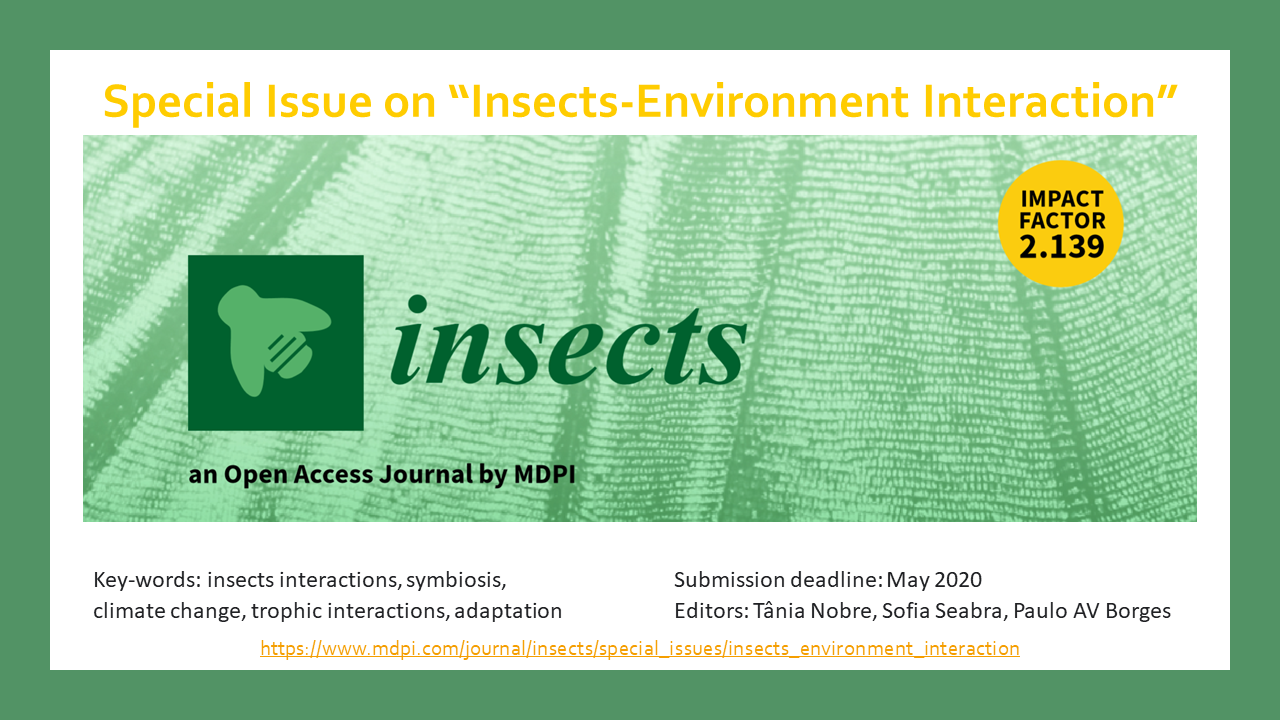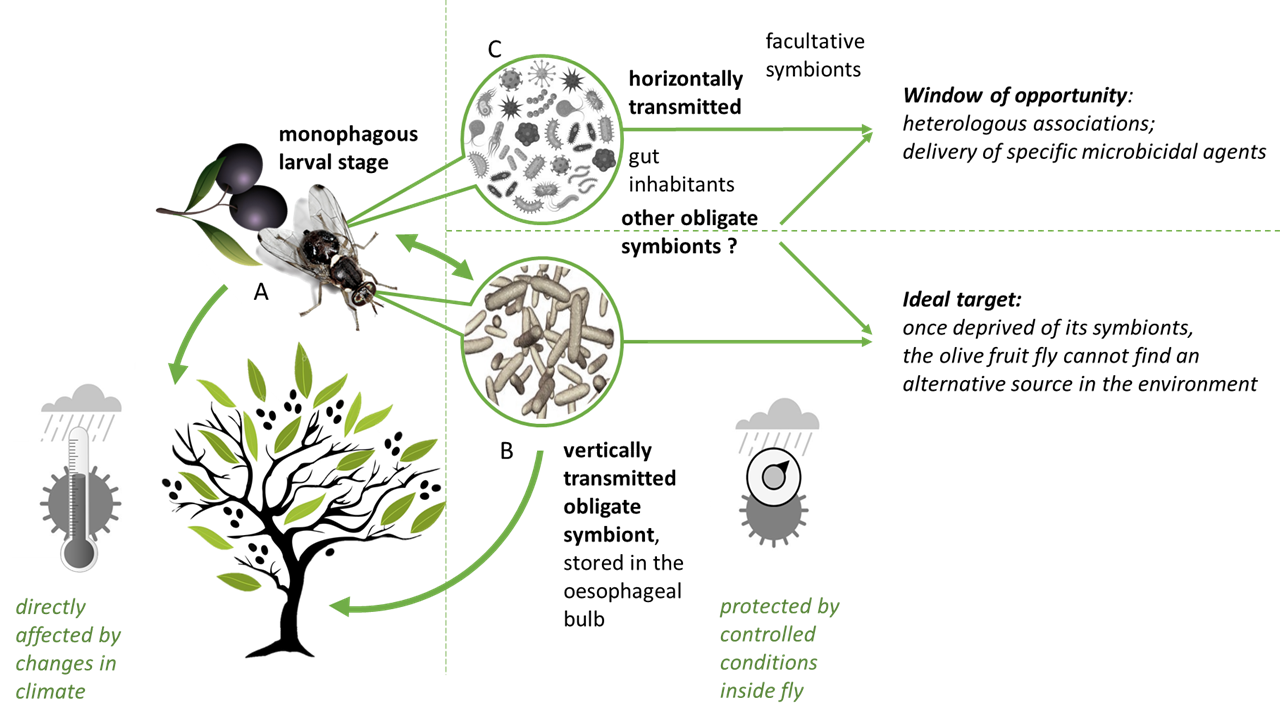
Dear Colleagues,
Insects represent the largest and most diverse group of living organisms and are implicated in a wide spectrum of interactions within the environment that they inhabit. Understanding how insects adopt an appropriate adaptive response to changes in their environment will aid in conserving nature and ecosystem services and is also of benefit for agriculture and forestry. Insect–environment interactions comprise complex associations, ranging from symbiosis and pollination, to (multi)trophic relations and co-evolution of defenses, or to nutrient re-cycling and response to climate change. For this Special Issue, we invite the submission of original research papers and mini-reviews covering all aspects of insect–environment interactions, both in natural and agricultural systems.
Dr. Tania Nobre (ICAAM, Universidade de Évora)
Dr. Sofia G. Seabra (cE3c, Universidade de Lisboa)
Prof. Paulo A. V. Borges (cE3c, Universidade dos Açores)
See: https://www.mdpi.com/journal/
Symbiosis in Sustainable Agriculture: Can Olive Fruit Fly Bacterial Microbiome Be Useful in Pest Management?
Tânia Nobre
https://www.mdpi.com/2076-2607/7/8/238
Abstract: The applied importance of symbiosis has been gaining recognition. The relevance of symbiosis has been increasing in agriculture, in developing sustainable practices, including pest management. Insect symbiotic microorganisms’ taxonomical and functional diversity is high, and so is the potential of manipulation of these microbial partners in suppressing pest populations. These strategies, which rely on functional organisms inhabiting the insect, are intrinsically less susceptible to external environmental variations and hence likely to overcome some of the challenges posed by climate change. Rates of climate change in the Mediterranean Basin are expected to exceed global trends for most variables, and this warming will also affect olive production and impact the interactions of olives and their main pest, the obligate olive fruit fly (Bactrocera oleae). This work summarizes the current knowledge on olive fly symbiotic bacteria towards the potential development of symbiosis-based strategies for olive fruit fly control. Particular emphasis is given to Candidatus Erwinia dacicola, an obligate, vertically transmitted endosymbiont that allows the insect to cope with the olive-plant produced defensive compound oleuropein, as a most promising target for a symbiosis disruption approach.
Funding: This work was supported by the “Fundação para a Ciência e Tecnologia” (FCT – Portugal), through the research project PTDC/ASP-PLA/30650/2017.

A Re-Evaluation of Olive Fruit Fly Organophosphate-Resistant Ace Alleles in Iberia, and Field-Testing Population Effects after in-Practice Dimethoate Use
Tânia Nobre, Luis Gomes, Fernando T Rei
https://www.mdpi.com/2075-4450/10/8/232
Abstract: The management of the olive fruit fly (Bactrocera oleae) is traditionally based upon the use of organophosphate insecticides, mainly dimethoate. In this evolutionary arms race between man and pest, the flies have adapted a pesticide resistance, implying two point-mutations of the Ace gene -I214V and G488S- and a 9bp deletion -Δ3Q. We revisited 11 Iberian locations to evaluate this adaptation of organophosphate (OP)-resistant alleles through amplicon sequencing. Screening for populations where the wild type is prevalent allows an identification of hotspots for targeted mitigation measures; we have hence refined the scale to the region with the lowest OP-resistant alleles frequency 71 locations were sampled and individuals checked using a fast and low-cost allele-specific-primer polymerase chain reaction (ASP-PCR) method]. An increase in Ace gene point-mutations was observed, and the Δ3Q mutation remains undetected. The lowest frequencies of the OP-resistant alleles remain in the west, underlining the hypothesis of an introduction of resistance from eastern Mediterranean areas. A field test was performed by sampling the fly population before and after in-practice dimethoate application. A clear reduction in olive fruit fly numbers was observed, with no relevant changes in the genotypic frequencies of the resistance alleles. The findings are discussed in frame of the type and intensity of the selection pressure that has led to the adaptation to resistance and its consequences from the producer perspective.
Funding: Thisworkwassupportedbytheproject‘IntegratedprotectionoftheAlentejoolivegrove. Contributions to its innovation and improvement against its key enemies’ with the reference ALT20-03-0145-FEDER-000029, co-financed by the European Union through the European Regional Development Fund, under the ALENTEJO 2020 (Regional Operational Program of the Alentejo). LG was fully supported by ALT20-03-0145-FEDER-000029. TN was partially supported by ALT20-03-0145-FEDER-000029 and by PTDC/ASP-PLA/30650/2017 (given by the “Fundação para a Ciência e Tecnologia”, FCT Portugal).
